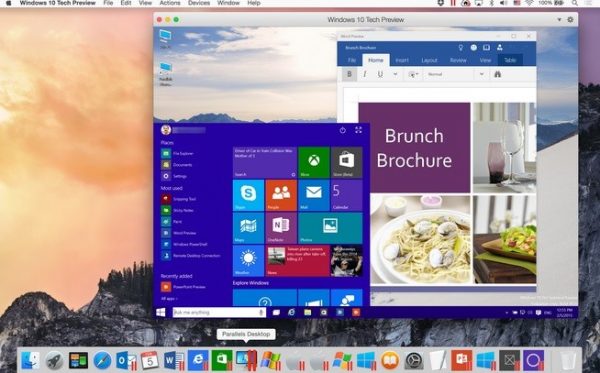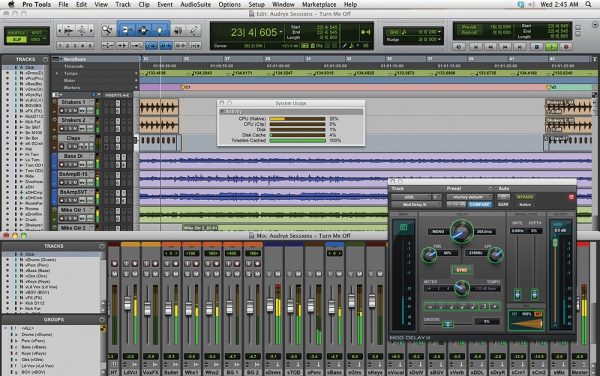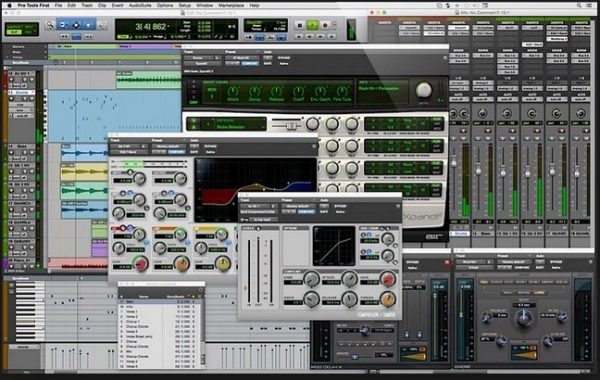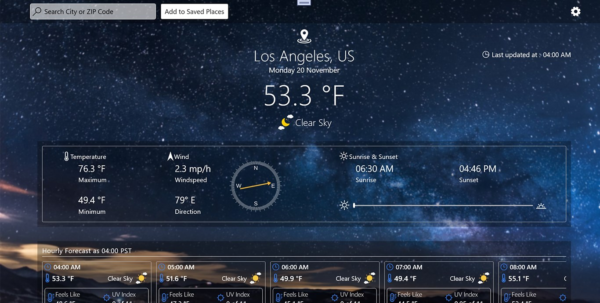Basically, Pro Tools is a digital audio workstation developed and released by Avid Technology for Microsoft Windows and macOS which can be used for a wide range of sound recording and production tasks. Generally, Pro Tools can be run as standalone software or can be operated using a range of external analog/digital converters and internal PCI Local Bus (PCI) and even on PCIe audio cards with onboard digital signal processors (DSP) to provide effects such as reverb, equalization, and compression for the users. Like all digital audio workstation software, Pro Tools for Windows 10 can perform the functions of a multitrack tape recorder and audio mixer, along with extra features that can only be executed in the digital province, such as non-destructive editing, using the Undo feature.
 Most of Pro Tools' basic functions can be controlled within Edit or Mix windows software, which the particular user can see on a computer screen while using it. The Edit window of the Pro Tools displays audio and Musical Instrument Digital Interface (MIDI) tracks provide the graphical representation of the information recorded or imported. In this Pro Tool, audio can be edited in a non-linear, non-destructive fashion. Pro Tools supports mostly 16-bit, 24-bit, and 32-bit float audio bit depths at sample rates up to 192 kHz. Even Pro Tools can handle mostly WAV, AIFF, AIFC, mp3, and formerly SDII audio file formats.
Most of Pro Tools' basic functions can be controlled within Edit or Mix windows software, which the particular user can see on a computer screen while using it. The Edit window of the Pro Tools displays audio and Musical Instrument Digital Interface (MIDI) tracks provide the graphical representation of the information recorded or imported. In this Pro Tool, audio can be edited in a non-linear, non-destructive fashion. Pro Tools supports mostly 16-bit, 24-bit, and 32-bit float audio bit depths at sample rates up to 192 kHz. Even Pro Tools can handle mostly WAV, AIFF, AIFC, mp3, and formerly SDII audio file formats.
Recently, Pro Tools has also incorporated a video editing feature, so that any users can import and handle high definition video file formats, which includes XDCAM, MJPG-A, PhotoJPG, DV25, QuickTime, and many more. Along with this, the additional features are time code, tempo maps, elastic audio, console automation, and surround sound abilities. The Pro Tools TDM mix engine employed 24-bit fixed-point arithmetic for plug-in processing and 48-bit for mixing; currently HDX hardware systems, HD Native, and native systems use the 32-bit floating-point resolution for plug-ins and 64-bit floating-point summing on Windows 10.
 Here are the 10 Prp Tools of Windows 10 for easy PC functionality. Just have a look at the given Pro Tools.
Here are the 10 Prp Tools of Windows 10 for easy PC functionality. Just have a look at the given Pro Tools.
HDX systems
The Avid Technology Company introduce a new line of DSP accelerated cards, named HDX cards, along with version 10 of its Pro Tools software. The cards included DSP processors which were manufactured by Texas Instruments, operating with increased computational precision – 32-bit floating-point versus the previous 24-bit fixed. The remunerations claimed for the new system included improved technical performance in terms of audio dynamic range, monitoring latency, and overall computational power when compared to the older HD line.
 In its marketing, the Avid Technology Company aimed the HDX system at customers requiring the highest and most consistent practically achievable levels of technical performance. The concrete benefit to the user was the more reliable creation of large and complex productions typical of those demanded in modern music production.
In its marketing, the Avid Technology Company aimed the HDX system at customers requiring the highest and most consistent practically achievable levels of technical performance. The concrete benefit to the user was the more reliable creation of large and complex productions typical of those demanded in modern music production.
HD systems
Both the Pro Tools – HD and HDX systems represent the company's professional product line. These Pro Tools rely on devoted chips that aid audio processing, in conjunction with rack-mounted interfaces, which handle outgoing and incoming audio, MIDI, and even sync connections. With the introduction of Avid's HDX line, the HD (“native”) interfaces, now no longer feature DSP, and after that, this feature has been reserved for HDX only. HD and HDX systems utilize proprietary cables to interconnect with external units. The older Pro Tools HD cards featured DSP chips from the Motorola 56k family; however, the newer HDX interfaces rely on DSP chips from Texas Instruments and have split facilities for managing track playback and even signal processing operations.
 At the launch of the Pro Tools HD cards, they were called HD Process cards. But, Nearly 2 years later, the HD Process cards were replaced by the HD Accel card, designed for a faster variant of the Motorola DSP chip and it provides almost twice the signal processing power per card. When the Apple Company changed the expansion slot architecture of the G5 to PCI Express, the Digidesign Company launched a line of PCIe HD Accel cards that both the Companies adopted the new card slot format and also slightly changed the combination of chips. There are TDM plug-ins that require the presence of Accel chips to run and therefore now it cannot run on the earlier non-Accel HD systems.
At the launch of the Pro Tools HD cards, they were called HD Process cards. But, Nearly 2 years later, the HD Process cards were replaced by the HD Accel card, designed for a faster variant of the Motorola DSP chip and it provides almost twice the signal processing power per card. When the Apple Company changed the expansion slot architecture of the G5 to PCI Express, the Digidesign Company launched a line of PCIe HD Accel cards that both the Companies adopted the new card slot format and also slightly changed the combination of chips. There are TDM plug-ins that require the presence of Accel chips to run and therefore now it cannot run on the earlier non-Accel HD systems.
LE Systems
Another Pro Tools that is LE (Limited Edition) systems performed data processing on the host CPU. In this, the purchasers were required to choose from a range of proprietary audio interfaces, one of which was required for all audio I/O basically for recording and playback function. The hardware thus doubled for a copy-protection mechanism for the software, as the software did not function without the specialized interface designed by Digidesign. The entry-level MBox range of interfaces connects via USB or Firewire 400 and all these have a stereo audio output, and even include a small number of line and microphone inputs. The more powerful 003 interfaces use FireWire and have significantly larger I/O abilities. The Eleven Rack, in addition to its many input options, includes in-box DSP processing via a FPGA chip offloads, along with the Eleven guitar amp/speaker emulation and guitar effects plug-in processing to the interface, which allows those plug-ins to run without taxing the host system.
9 System Changes
The company has now introduced one hardware-independent software package named Pro Tools Standard, which is the combination of upgraded Pro Tools LE with some of the features of HD and effectively merged it into the new type of Pro Tools. Now, with this development in the Pro Tools, the Pro Tools 9 has no proprietary hardware requirement, allowing the use of the software with any interface. This kind of Pro Tool can operate using the internal sound card of a PC via the Audio Stream Input/Output (ASIO) driver and a Mac using Core Audio. On the other hand, the Mac Core Audio also allows first time the use of aggregate devices, which allows the use of more than one interface at the same time. Well, this feature can also be achieved on a PC by using the third-party application known as ASIO4ALL. In addition to this, the Pro Tools 9 also included a new keyboard shortcut for “New Playlist”, to operate it more comfortably.
M-Powered Systems
In 2004–2005, M-Audio, formerly Midiman was acquired by Avid Technology, and after that Digidesign soon released Pro Tools M-Powered, which brought Pro Tools LE functionality to a subset of M-Audio USB, FireWire and PCI interfaces. Pro Tools M-Powered uses the iLok license as a copy protection and was formerly the only way to run Pro Tools without using Avid and Digidesign hardware.
M-Powered Essential
This is another Pro Tools, which was scaled-down version of the M-Powered system. The development of this Pro Tools was aimed at the starter consumer market, and offers very limited scope, with only 16 tracks, no third-party plug-ins, and limited USB device support.
SE
The Pro Tools SE is a stripped-down version of what used to be Pro Tools LE, which was also made for beginners. The software is sold in one of three bundles along with a hardware unit for guitarists, keyboardists, and vocalists. This Pro Tool also comes with the M-Audio Fast Track and MobilePre USB audio interfaces except for the “Ultra” sub-series. In this, there is no option to upgrade to the full version of Pro Tools from Pro Tools SE.

Control surfaces
Both the Digidesign and Avid Technology control surfaces attempt to bridge the gap between old-style analog desks and modern DAWs by providing physical controls for the Pro Tools software. These include the C|24, a 24-fader surface with 16 built-in pre-amps, and the ICON: Integrated Console Environment, which works alongside Pro Tools|HD or Ultimate. Currently, the Avid S6 control surface superseded the ICON as the flagship controller, though ICON systems remain in use worldwide, in mix studios and post-production houses, and were the bestselling medium/large format “console” of all time VENUE, a similar system, was released for live-sound applications. The Command|8 is a smaller eight-fader control surface. Meanwhile, in this time period, the Pro Tools compatible control surfaces have also been developed by other companies. For example, the Audient ASP2802 has integrated with the DAW control and is compatible with Pro Tools as well as Logic Pro and Cubase, which therefore provides an external analog mixing interface for the computers.
Related Products and Services
In 2002, Digidesign introduced an official Pro Tools training curriculum and certification program, which includes courses in music and post-production. In this, the Music Production and DV toolkits increase the abilities of non-HD Pro Tools systems. As a result, both these increase the maximum number of tracks and the highest possible sample rate to 96 kHz and include additional plug-ins. The LE-only DV toolkit adds feet and frames and time code timelines and functionality.
Advanced Instrument Research (AIR)
Now the Avid Company acquired the German company Wizoo, formerly working mainly for Steinberg and developers of virtual instruments. They further pronounced the creation of Advanced Instrument Research (AIR), which meant Avid, would be developing virtual instruments and plug-ins which will be used in Pro Tools.

This thing also resulted in the landmark improvement of Pro Tools, versions 8 through 10. This relied seriously on the presence of AIR Virtual Instrument plug-ins to bring it closer to its competitor Logic Pro. Those included with Pro Tools Standard include:
• Structure FREE, a sample playback instrument.
• Boom, a drum machine
• Xpand2, a multi-timbral sample-playback/synthesis plug-in
• DB33, a Hammond Organ emulator
• Vacuum, a monophonic vintage synth.
• Mini Grand, Piano.
AIR also contributes reverbs, dynamics, modulation, and other effects as part of the Pro Tools, all of these works in native format only.
Some of the additional virtual instruments features for Pro Tools that AIR has created include:
• Hybrid, a high definition Synthesizer
• Velvet, vintage electric piano
• Transfuser, real-time loop, phrase and groove creator
















